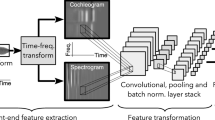Abstract
This paper proposes a new method for signal classification based on a combination of deep-learning (DL) image classifiers and recently introduced nonlinear spectral analysis technique called quantile-frequency analysis (QFA). The QFA method converts a one-dimensional signal into a two-dimensional representation of quantile periodograms (QPER) which represent the signal’s oscillatory behavior in the frequency domain at different quantiles. With a moving window, the QFA method can also covert a signal into a sequence of such two-dimensional representations, called short-time quantile periodograms, that are localized in time to represent the signal’s time-dependent or nonstationary properties. The DL image classifiers take these representations as input for signal classification. The benefit of this QFA-DL classification method in comparison with the traditional frequency-domain method based on the power spectrum and spectrogram is demonstrated by a numerical experiment using real-world ultrasound signals from a nondestructive evaluation application.










Similar content being viewed by others
Data Availability
data and computer code available at https://www.math.umd.edu/~bnk/DATA/ and https://github.com/IBM/qfa.
Notes
D. Prahbu, personal communication to B. Kedem, May 25, 1994.
References
Kay, S.: Modern Spectral Estimation: Theory and Application. Prentice-Hall, Englewood Cliffs (1988)
Marple, S., Jr.: Digital Spectral Analysis, 2nd edn. Dover Publications, New York (2019)
Abedin, M., Johnston, P., Prabhu, D.: Disbond detection using peak amplitude of pulse-echo signals for various thicknesses and transducer frequencies. In: Thompson, D., Chimenti, D. (eds.) Review of Progress in Quantitative Nondestructive Evaluation, vol. 12, pp. 1539–1546. Plenum Press, New York (1993)
Allin, J.: Disbond detection in adhesive joints using low-frequency ultrasound, Ph.D. Dissertation, Department of Mechanical Engineering, University of London (2002)
Cerniglia, D., Montinaro, N., Nigrelli, V.: Detection of disbonds in multi-layer structures by laser-based ultrasonic technique. J. Adhes. 84(10), 811–829 (2008)
Dutta, D.: Ultrasonic techniques for baseline-free damage detection in structures, Ph.D. Dissertation, Department of Civil and Environmental Engineering, Carnegie Mellon University (2010)
Li, T.-H.: Laplace periodogram for time series analysis. J. Am. Stat. Assoc. 103(482), 757–768 (2008)
Li, T.-H.: Quantile periodograms. J. Am. Stat. Assoc. 107(498), 765–776 (2012)
Li, T.-H.: Time Series with Mixed Spectra. CRC Press, Boca Raton (2013)
Mendel, J.: Tutorial on higher order statistics (spectra) in signal processing and system theory: theoretical results and some application. Proc. IEEE 79(3), 278–305 (1991)
Brillinger, D.: An introduction to polyspectra. Ann. Math. Stat. 36, 1351–1374 (1965)
Nikias, C., Petropulu, A.: Higher-Order Spectra Analysis: A Nonlinear Signal Processing Framework. Prentice-Hall, Englewood Cliffs (1993)
Khoshnevis, S., Sankar, R.: Applications of higher order statistics in electroencephalography signal processing: a comprehensive survey. IEEE Rev. Biomed. Eng. 13, 169–183 (2019)
Goodfellow, I., Bengio, Y., Courville, A.: Deep Learning. MIT Press, Cambridge (2016)
Li, T.-H.: From zero crossings to quantile-frequency analysis of time series with an application to nondestructive evaluation. Appl. Stoch. Models Bus. Ind. 36(6), 1111–1130 (2020)
Chen, T., Sun, Y., Li, T.-H.: A semi-parametric estimation method for the quantile spectrum with an application to earthquake classification using convolutional neural network. Comput. Stat. Data Anal. 154:107069
Virkkunen, I., Koskinen, T., Jessen-Juhler, O., Rinta-aho, J.: Augmented ultrasonic data for machine learning. J. Nondestr. Eval. (2021). https://doi.org/10.1007/s10921-020-00739-5
Haile, M., Zhu, E., Hsu, C., Bradley, N.: Deep machine learning for detection of acoustic wave reflections. Struct. Health Monit. 19(5), 1340–1350 (2019). https://doi.org/10.1177/1475921719881642
Guo, F., Li, W., Jiang, P., Chen, F., Liu, Y.: Deep learning approach for damage classification based on acoustic emission data in composite materials. Materials (2022). https://doi.org/10.3390/ma15124270
Sikdar, S., Liu, D., Kundu, A.: Acoustic emission data based deep learning approach for classification and detection of damage-sources in a composite panel. Cmposites Part B (2022). https://doi.org/10.1016/j.compositesb.2021.109450
Bedrosian, A., Thompson, M., Hrymak, A., Lanza, G.: Developing a supervised machine-learning model capable of distinguishing fiber orientation of polymore composite samples nondesctructively tested using active ultrasonics. J. Adv. Manuf. Process. 5(1), e10138 (2023). https://doi.org/10.1002/amp2.10138
Koenker, R.: Quantile Regression. Cambridge University Press, Cambridge (2005)
Li, T.-H.: A robust periodogram for high resolution spectral analysis. Signal Process. 90(7), 2133–2140 (2010)
Li, T.-H.: On robust spectral analysis by least absolute deviations. J. Time Ser. Anal. 33(2), 298–303 (2012)
Zoubir, A., Koivunen, V., Ollila, E., Muma, M.: Robust Statistics for Signal Processing. Cambridge University Press, Cambridge (2018)
Li, T.-H.: Robust coherence analysis in the frequency domain. In: Proceedings of the European Signal Processing Conference (Aalborg, Denmark), pp. 836–871 (2010)
Nelsen, R.: An Introduction to Copulas, 2nd edn. Springer, New York (2006)
Glorot, X., Bengio, Y.: Understanding the difficulty of training deep feedforward neural networks. In: Proceedings of the 13th International Conference on Artificial Intelligence and Statistics (Sardinia, Italy), pp. 249–256, (2010)
Acknowledgements
The author would like to thank the anonymous reviewers for constructive comments and suggestions which led to an improved presentation.
Funding
None.
Author information
Authors and Affiliations
Contributions
TL was the sole author of the manuscript.
Corresponding author
Ethics declarations
Conflict of interest
The authors declare no competing interests.
Additional information
Publisher's Note
Springer Nature remains neutral with regard to jurisdictional claims in published maps and institutional affiliations.
Supplementary Information
Below is the link to the electronic supplementary material.
Rights and permissions
Springer Nature or its licensor (e.g. a society or other partner) holds exclusive rights to this article under a publishing agreement with the author(s) or other rightsholder(s); author self-archiving of the accepted manuscript version of this article is solely governed by the terms of such publishing agreement and applicable law.
About this article
Cite this article
Li, TH. Quantile-Frequency Analysis and Deep Learning for Signal Classification. J Nondestruct Eval 42, 40 (2023). https://doi.org/10.1007/s10921-023-00952-y
Received:
Accepted:
Published:
DOI: https://doi.org/10.1007/s10921-023-00952-y




